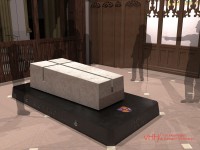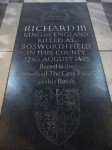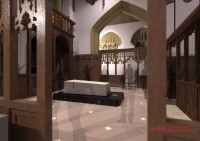 As there has been no appeal lodged to contest the ruling of the High Court that the remains of King Richard III are to be reinterred in Leicester Cathedral, plans for the reburial have been finalized. The Cathedral Fabrics Commission for England have approved the tomb design of architects van Heningen and Haward. There’s no inlaid marble white rose of York underneath the raised platform in this version. Instead, a plinth made of black Kilkenny marble will seal the tomb beneath the Cathedral floor. Richard’s name, dates and motto will be engraved into the sides of the plinth — the nature of the marble will make the lettering appear white in contrast with the dark color of the smooth surface — while his coat of arms is inlaid in marble and semi-precious hard stones at the top foot of the plinth.
As there has been no appeal lodged to contest the ruling of the High Court that the remains of King Richard III are to be reinterred in Leicester Cathedral, plans for the reburial have been finalized. The Cathedral Fabrics Commission for England have approved the tomb design of architects van Heningen and Haward. There’s no inlaid marble white rose of York underneath the raised platform in this version. Instead, a plinth made of black Kilkenny marble will seal the tomb beneath the Cathedral floor. Richard’s name, dates and motto will be engraved into the sides of the plinth — the nature of the marble will make the lettering appear white in contrast with the dark color of the smooth surface — while his coat of arms is inlaid in marble and semi-precious hard stones at the top foot of the plinth.
On top of the plinth will be a large rectangular block of Swaledale fossil stone, quarried in North Yorkshire, deeply incised with a cross along its full length and breadth. The fossil stone is so called because it is peppered with visible fossils, once-living beings long dead whose remains have been brought to light and immortalized in stone, a metaphorically significant analogy to Richard’s fate.
 Underneath the plinth, Richard’s remains will be laid to rest in a lead ossuary which will be placed in an oak coffin which in turn be placed in a brick lined vault under the Cathedral floor. The precise design of the wooden coffin is still being worked out and will be announced at a later date, but the carpenter who will make the coffin has been selected already. It’s Michael Ibsen, Richard’s sixteenth grand-nephew, a direct descendant down the maternal line of Richard’s sister Anne of York whose mitochondrial DNA helped identify the King’s remains. He’s a cabinet and furniture maker by trade, so it’s a fitting commission in every way. Ibsen accepted the work offer with alacrity, calling it “a very appropriate gift to offer to [his] royal ancestor.”
Underneath the plinth, Richard’s remains will be laid to rest in a lead ossuary which will be placed in an oak coffin which in turn be placed in a brick lined vault under the Cathedral floor. The precise design of the wooden coffin is still being worked out and will be announced at a later date, but the carpenter who will make the coffin has been selected already. It’s Michael Ibsen, Richard’s sixteenth grand-nephew, a direct descendant down the maternal line of Richard’s sister Anne of York whose mitochondrial DNA helped identify the King’s remains. He’s a cabinet and furniture maker by trade, so it’s a fitting commission in every way. Ibsen accepted the work offer with alacrity, calling it “a very appropriate gift to offer to [his] royal ancestor.”
The oak coffin will play an important role in the reburial ceremony. The ossuary will be placed in the coffin at the University of Leicester and the coffin will then be transported to the Cathedral along a public route that will follow what we know of King Richard’s movements on the last days of his life. It will be received formally by Cathedral officials accompanied by the medieval service of Compline. The coffin will then lie in state covered with a pall that will feature scenes from Richard’s life and death. The public will be invited to pay their respects at this time.
The reburial service will not be a funeral as Richard had one of those already. Instead it will be a special service designed according to detailed research of medieval reinterment rites (reburials were quite common back then, and there are extant sources describing the services). The service will conclude with the coffin being lowered into the brick vault. The tomb will be sealed overnight with the stone plinth and the sarcophagus-like Swaledale fossil stone marker.
 The tomb and marker will be installed in an ambulatory (an open walking space) between the new Chapel of Christ the King and the sanctuary under the tower, the most holy place in the Cathedral where the main altar stands. It will be a peaceful, quiet spot, separated from the main worship area of the Cathedral by the relocated Nicholson screen, an ornately carved screen created in the 1920s by ecclesiastical architect and baronet Sir Charles Nicholson to separate the nave from the chancel.
The tomb and marker will be installed in an ambulatory (an open walking space) between the new Chapel of Christ the King and the sanctuary under the tower, the most holy place in the Cathedral where the main altar stands. It will be a peaceful, quiet spot, separated from the main worship area of the Cathedral by the relocated Nicholson screen, an ornately carved screen created in the 1920s by ecclesiastical architect and baronet Sir Charles Nicholson to separate the nave from the chancel.
Cathedral officials hope to start the construction work this summer so the building can be finished by early 2015 in time for a Spring reburial. The total budget for this project is £2,500,000 ($4,240,000). The Diocese of Leicester will contribute £500,000 ($848,000) and £100,000 ($170,000) has already been collected in donations. Much of the rest will come from large grants from trusts, foundations and private donors. There will be a fundraising appeal later this year targeted to the Leicester community, giving local residents the opportunity to fund a specific element of the reburial project. Meanwhile, donations are open. If you’d like to contribute, you can do so online here or you can print out this pdf form for sending in a donation by mail.
At last King Richard 111 can Rest in Peace.
R.I.P. – (R)ichard (I)II (P)erished in this Parish (in absence of a horse).
Well, I really am a big fan of that second black memorial stone at ground level, and if somebody feels the necessity to hold a ceremony, there should not be a problem at all. However, anything more seems rather absurd to me, and I am not so sure that Richie himself would have liked it.
The first example, moreover, with that bulky and rather ‘unbritish’ white monster atop that other black stone is not even appropriate for Disneyworld. So whom do they want to impress in Leicester Cathedral ? Tourists from China ? Why the two diffeent designs ? Did I get anything wrong here ?
Michael Ibsen gets to make the coffin? How cool is that?
Sad to hear the white marble rose of York is out, I thought that was a nice touch.
Judging from the “ghost people” in the architects’ renderings, strolling around in all directions, pointing randomly and sometimes accompanied by tots, tourists are indeed who the designers have in mind.
I’m disappointed. It seems to me that a tomb more akin to Henry VII’s would be more befitting a monarch. Even the more sober tomb of Richard I at Rouen is at least dignified. This current thing is not royal and is hardly art at all.
And the amount of money they’re spending to make this thing. Ridiculous.
I visited Leicester Cathedral last year during the Society for Historical Archaeology meeting, and the tomb will be a tight fit. Compared to Westminster, Durham, or York, Leicester is a very small space indeed.
Not that I was asked :p but IMHO I would would have liked to see a effigy statue of him in armour as befitting a King and a Knight, resting on top as in the tradtinal middle ages style perhaps a boar at his feet and some white roses. But I guess the “moderns” will get their way, still think mine would have been a bigger tourist draw..because it seem to be mostly about that.I hope the services are on the net because my chance to go to it are..well snowball in hades. Hummm wonder if they would hire me as a profesinal mourner aka as in “Oliver” :skull:? Basicly I’m glad there finaly getting him off the shelf and back in to the grave.
This remains a fascinating story.
What will become of David Kindersley’s memorial slab, which you illustrate? Kindersley was one of the most distinguished letter carvers and typographers of the 20th century and this slab is a beautiful, important piece of work – far more distinguished than the pastiche and compromise that are the hallmark of the silly memorial agreed upon. To the complaints of the Richard III Society, with its earlier grandiose, vulgar schemes for the tomb, that it was insufficiently grand for a king, one can only refer to the simple Westminster Abbey, Unknown Warrior tomb slab, the best-known, best-loved tomb in the United Kingdom. http://londoniscool.com/wp-content/uploads/2011/01/unknown-soldier.jpg
Or holding a dagger, as befits a serial murderer, “Countess”?
This take on the final tomb design has charm. http://anglicanmemes.com/2014/06/16/leicester-cathedral-revise-richard-iiis-tomb-design-to-appease-yorkshire/
Not a fit place or monument for a much maligned and last true king of England. He was an honourable and brave man, unlike his successor who was a real murderer and who “waded in blood” throughout his whole reign. Richard only executed four men who were plotting to murder him. He should have a memorial according to his rank as an apology for all the lies that have been told about him.
“….last true king of England.” Henry VIII, son of Edward IV’s eldest daughter, Elizabeth, was heir to the house of York, but logic is seldom a strong point when “White Boar” enthusiasts get going.
Henry VIII was the son of a usurper with no true royal blood and the illegitimate daughter of Edward IV so not true King.
I would add to my above comment that Henry VII judicially murdered all the Plantagenet blood descendants and Henry VIII finished the job by executing the elderly Countess of Salisbury who had comitted no crime except to be the daughter of the Duke of Clarence Richard III’s brother. and the Duke of Suffolk the last surviving nephew of Richard. Yet Henry VII has a huge tomb in Westminster Abbey. Why does he not have an executioner’s axe in his hand Mr.Bizarre Rabbit? but, of course, Roger Mortimer was the Greatest Traitor – fact!
I bow to your command of logic and of the English language, Clio.
Oh dear Me Mr Lapinbizarre/Roger Mortimer. What part of my post offended you the most? I stated my idea,that was all. I stated a fact that Richard was a Knight and the fact that he was a King. I fell he should have a tomb more in keeping with the style of tombs during his life time, insted of our present time. I cant believe that would or should have upset you. I was only stating my personal idea. I did note that. Ok kid gloves off I highly agree with clio who jumped to my defence. Thank you clio. I think it comes as no surprise to anyone here that I’m a Richard supporter. I prefer not to argue with you Roger Mortimer. I will simply stand behind facts and when you check out the facts it’s Richard that comes up smelling like a white rose.
Countess, I am with you shoulder to shoulder in Richard’s army and I am gutted that he is not to be buried in a great cathedral as befits a king who has suffered greatly from prejudice and untruths put about by his enemies. The present design has no medieaval connections, it is, in my opinion, a lazy and cheap production with no design appreciation about it. I wonder if it is coloured by moral judgement rather than historical knowledge. Richard was not a ursurper or murderer, he was an elected king and showed he would have been a great hearted and just ruler had he been given time to consolidate his position. He should be commemorated as such. Also, we are not certain that he had full funeral rites as there is no evidence that the Tudor usurper even ordered a burial for the dead king.
The English monarchy ceased to be elective at the Norman Conquest (1066), Clio, so “elected king” is an odd term to apply to Richard. A convenient fiction, perhaps, to sidestep the inconvenient fact that Richard pushed aside not only the “illegitimate” (your term) offspring of his brother Edward, but also the son and daughter of his elder brother George, whose legitimacy has never, to my knowledge, been questioned? Incidentally, might not Henry VII be legitimately termed “elected”, by virtue of the recognition pf his kingship by act of parliament?
It is indeed sad that the white marble rose of York was not included. I know that Leicester Cathedral is now part of the Anglican community however; I believe that King Richard 111 (for the sake of authenticity) should have been buried according to the Roman Catholic Rite that existed at the time of his death.
Well said Clio. I totally concur with your sentiments. The greatest disaster in England was the rise of usurper House of Tudor. I wonder whether Margaret Beaufort was buried with her murdering son.